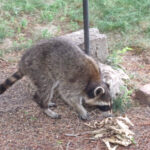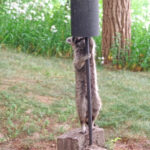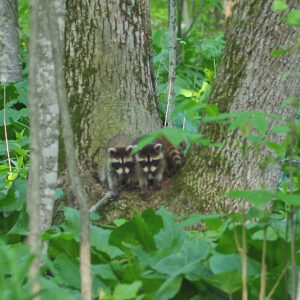Greetings, BugFans,
The first thing that the BugLady noticed when she went out to refill the bird feeders the other morning was a bunch of divots in the ground around the feeder. Skunks will do that as they search for grubs in the soil at night; raccoons will, too. The second thing she noticed was that the bird bath had been tipped off of its base – that happens sometimes when some low-slung animal puts its front feet up on the rim and leans over to lap the water. The third thing she noticed was that the water that remained in the bird bath was muddy.
Raccoon.
This article is a revision of an article that the BugLady wrote a few years ago for the BogHaunter, the newsletter of the Friends of the Cedarburg Bog.
 The name “raccoon” comes from a Powhatan word “aroughcun,” whose root means “one who rubs, scrubs and scratches with its hands.” Originally classified in the bear family (they were called “washer bears” and “long-tailed bears”), raccoons are now in their own family, the Procyonidae, along with the coatimundis of Central America and the Southwestern US. Their scientific name is Procyon lotor (“Procyon” means “doglike” and “lotor” means “washer”).
The name “raccoon” comes from a Powhatan word “aroughcun,” whose root means “one who rubs, scrubs and scratches with its hands.” Originally classified in the bear family (they were called “washer bears” and “long-tailed bears”), raccoons are now in their own family, the Procyonidae, along with the coatimundis of Central America and the Southwestern US. Their scientific name is Procyon lotor (“Procyon” means “doglike” and “lotor” means “washer”).
Raccoon ancestors probably originated in Central America and southeastern North America and moved north along the river valleys. Reports by early explorers in the upper Midwest didn’t mention them, and their populations may have boomed here only in the last century. They got a helping hand from the expansion of agriculture and the elimination of the cougars and bobcats that preyed on them. Today, they can be found from Alaska through Central America.
Raccoons are remarkably flexible about the places they call home. They live in wooded areas and wetland edges, and they’re at home on both urban and suburban landscapes. Raccoons make dens in rock piles and old trees, in chimneys and attics, and under decks, and they will use a burrow made by another animal.
 These short-legged, pear-shaped, masked animals average 15 to 21 inches long (without the ringed, bushy tail) and 10 to 30 pounds (of solid muscle), but they occasionally top 50 pounds (the BugLady would definitely cross the road if she saw a spaniel-sized raccoon). One of the BugLady’s neighborhood raccoons (raccoons are a given where there are summer cottages and al fresco dining) looks like it’s close to 25 pounds. Their top running speed is 10 to 15 mph, and they are good swimmers (though they prefer not to, because their fur isn’t very waterproof) and great climbers. They prefer to scramble up a tree when they’re alarmed, though they don’t like climbing the smooth bark of beech trees, and they descend head first, gripping with feet that are swiveled backwards. They make a variety of hisses, purrs, growls, chatters, and bloody screeches. Raccoon tracks resemble the prints of human hands and feet, which gave them a special place in the mythologies of some Indian tribes.
These short-legged, pear-shaped, masked animals average 15 to 21 inches long (without the ringed, bushy tail) and 10 to 30 pounds (of solid muscle), but they occasionally top 50 pounds (the BugLady would definitely cross the road if she saw a spaniel-sized raccoon). One of the BugLady’s neighborhood raccoons (raccoons are a given where there are summer cottages and al fresco dining) looks like it’s close to 25 pounds. Their top running speed is 10 to 15 mph, and they are good swimmers (though they prefer not to, because their fur isn’t very waterproof) and great climbers. They prefer to scramble up a tree when they’re alarmed, though they don’t like climbing the smooth bark of beech trees, and they descend head first, gripping with feet that are swiveled backwards. They make a variety of hisses, purrs, growls, chatters, and bloody screeches. Raccoon tracks resemble the prints of human hands and feet, which gave them a special place in the mythologies of some Indian tribes.
Another reason they’re so successful is that they eat practically everything – they’re the Omnivore’s Omnivore. A typical diet, which changes seasonally, includes about 40% invertebrates, 33% plants, and 27% vertebrates, but they’ll also feed on carrion and raid garbage cans. The BugLady fondly recalls lying in bed at night, listening to raccoons rolling the garbage can downhill to the edge of the woods so they could work on the raccoon-proof lid in peace.
Raccoons are often pictured dipping their food in the water, but they don’t dunk it to make up for a lack of saliva, as was once thought. They catch much of their food in shallow water, and they often manipulate it before eating (OK – they play with their food). Water enhances their tactile senses by softening the tough skin layer that protects their paws. Whatever prey that the BugLady’s visitor(s) found was washed in the bird bath.
They help to control rodent populations, but they also prey on ground-nesting birds. The BugLady once saw one chasing a woodcock through a prairie – the bird twittering along just above the grass tops and out of reach of the bounding raccoon, leading it away from her chicks. The BugLady used to live close to the Cedarburg Bog, and she heard crane alarm calls at night as raccoons and other predators moved through the nesting areas.
Their combination of intelligence and dexterity makes them worthy competitors as they move into cities. Though they don’t have opposable thumbs, they are smart enough to figure out how to open an array of doors and latches, and studies of raccoon intelligence show that they can recall their solution up to three years later. One research project at the Field Station that involved sinking empty yogurt cups into the ground to trap insects had to be redesigned after a raccoon pulled up all the still-fragrant containers.
Female raccoons with kits enjoy a privileged status in raccoon society (Happy Mother’s Day).
Raccoons put on a layer of fat as winter approaches, and their thick undercoat insulates them well, but when food becomes scarce, they take a nap. They’re deep sleepers rather than true hibernators; they’ll bed down during the worst of winter, often in family groups, sometimes losing half their body weight before the weather warms up again.
In the wild, most raccoons live only about three to six years; Great Horned Owls, hunting, disease and parasites take their toll, as do cars.
Yeah – they’re adorable – “almost human” – but raccoons are NOT good pets. In Wisconsin, you need a license to adopt a wild raccoon or to import one from out of state (unregulated relocation of raccoons for hunting purposes in the past is responsible for spreading rabies along the mid-Atlantic coast). Raccoons are wild animals that play by raccoon rules, and they can go from cuddly to cantankerous in seconds. The BugLady was showing a “tame” raccoon to a class at a nature center once, and she suddenly had 18 holes in one hand and 24 in the other (and an appointment for a tetanus shot).
The BugLady
